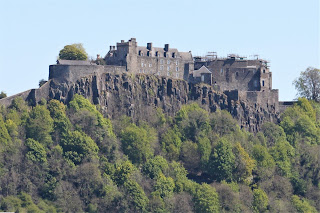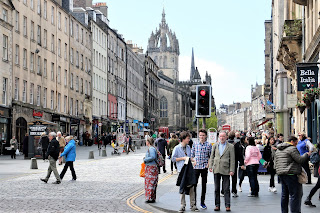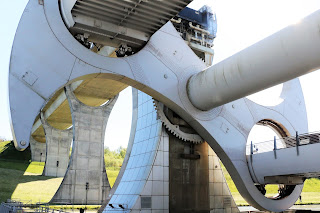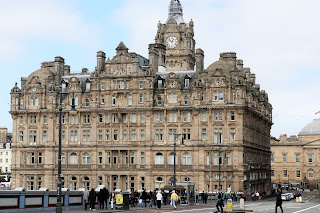 |
| The four intrepid Orkney travelers! |
The Orkney Islands definitely exceeded our expectations. The
weather was gorgeous, mostly sunny with incredible blue skies (quite unusual as
everyone kept telling us!). It was extremely windy, but we kind of got used to
it. And the Orcadians, as they call themselves, described the wind we had as
“mild!” The people could not have been friendlier – very warm and so accommodating.
Life on Orkney Island felt gentle and kind. Made us think that these simple
people have not lost sight of what is really important (as so many of us have).
 |
| Our "Orkney blue" car |
This little island is jampacked with things to see and do.
With our “Orkney blue” colored Suzuki, we did our best to see as much as we
could in the week that we were there. The extreme prehistory here is simply unparalleled
in any other area of the planet. And everything is so accessible, and
unprotected, it is almost frightening.
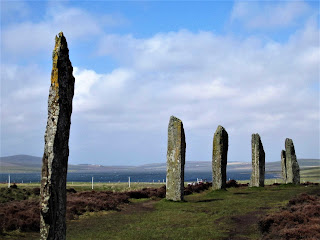 |
| The 5,000-year-old Ring of Brodgar |
On a side note: There is little love lost between Scotland
and England. The English tend to think they are better and have always believed
that life in Great Britain began in southern England (near Stonehenge) and then
moved north. However, the prehistoric discoveries in Orkney prove that it was
exactly the opposite -- life began in the north, in Scotland, and moved south.
And the Scottish could not be happier about this new revelation!
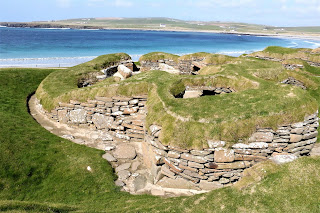 |
| Skara Brae by the sea |
Skara Brae
This was one of our favorites. Skara Brae is a prehistoric
village that was uncovered by a severe storm back in 1850. While most
prehistoric remains tend to be monumental structures, Skara Brae shows us how
regular people of 5000 years ago lived. (And their homes actually feel homey!)
Plus Skara Brae has been carbon dated and found to be older than either
Stonehenge or the Pyramids!
 |
| "The Skara Brae hand grenade" |
The excellent Visitor’s Center started us off with a short
film and a walk through their small museum. Fabulous artifacts including mysterious
carved objects with no known purpose. Strange lumpy symmetrically-cut blobs.
Frank thought one looked like a hand grenade or a throwing weapon of some sort.
Another theory, they may have been used to denote power: in a meeting the
person holding the object may have had the “floor” and the right to speak.
[Note to Nancy: Like passing the shell?]
 |
| Skara Brae restoration of House 7 |
Outside, we entered an impressive restoration of a prehistoric
village house. House 7, as they call it, had two beds, niches with shelves in the wall
for storage, a central fire pit, a remarkable stone table with shelving that
looked like a hutch in a modern kitchen, and even an aquarium of sorts for live
fish to swim – probably fish for a family’s dinner or bait for a fishing trip.
 |
| The beach in front of Skara Brae |
We walked down to the water’s edge to see the ancient site
and found a beautiful beach with white sand and blue water that the denizens of
the past must have enjoyed. Remove the wind and the cold, and you might think
you were in the Caribbean!
 |
| Actual interior of a Skara Brae home |
The actual physical site was stunning, right there on the edge where
the land meets the water. We roamed thru the stonework structure of
Skara Brae with our imaginations on our sleeves. So much fun to envision this stone-aged village
which was created here over 5,000 years ago, with the simple people who lived
in it going about every day business, working, fishing, solving survival
issues, while maybe even playing some sports or games. Skara Brae really allowed us a
modern-day touch into the past!
 |
Unexplained angled corner cut
at Stones of Stennes |
The Standing Stones
of Stennes
The Standing Stones of Stennes are the largest stones on the
island and date back to at least 3100 B.C. The availability of the artifacts here make us think the people of Orkney are so
trusting. Incredibly, we could walk right up and touch these 5,000-year-old
stones with virtual impunity!
These flat stone monoliths are heavy and tower above the
height of any human. They form a ceremonious religious circle, it is believed, like the famous one at Stonehenge. Many
of the slabs have a curious slanted cut on one side corner at the top of the
stone, adding to the mystery of the creation. The winds were fierce here, but
we enjoyed roaming the site in spite of it, grabbing respite from time-to-time behind
some of the slabs from the powerful gale-force gusts that pounded us unrelentingly.
 |
| Maeshowe mound with crawl-through entrance |
Maeshowe
Maeshowe appears to be a nondescript grass-covered mound in
the middle of a field, but it is an ancient cairn (underground tomb) used 5000
years ago. The entrance was so low, we had to crouch down and “crab-walk” along
a narrow passageway lined with massive stone slabs.
No bones were found here, so no one knows if it was a tomb,
a time-piece, or perhaps even a temple. There are several theories on each
alternative. The low entrance may have
been designed to force everyone entering it into a low-lying position showing
respect – thus making it a temple. The entrance is also perfectly aligned for the day of the winter
solstice that when a ray of sunlight enters the tomb from the entrance way on that day, it illuminates a low-lying
stone at the front of the enclosure – thus making it a timepiece.
At one point in its history, Vikings discovered the cairn
and lived in it. Probably for shelter from the unceasing winds. They left
behind some "runes" (early system of writing) carved in the stone in the interior.
One ancient rune writer in the stone made everyone laugh. Instead of leaving some
words of wisdom for the future, he wrote, “I am the best rune carver that ever
lived.” Nothing like a Viking braggart!
 |
| The Head of Brodgar |
Ring of Brodgar
The Ring of Brodgar is the biggest stone circle in Scotland
and considered one of the finest stone circles in the world. The original
circle was made up of sixty stones; twenty-seven of the original stones are
still standing. Each stone is different. As our friend Amy said, it was almost
like walking through an art gallery!
One of the stones looked like a face, and we found out later
that it is called “The Head of Brodgar”. No one knows the purpose of the
circle, but Anne is convinced that the ring was designed like a helipad to
provide a landing spot for aliens! Frank
thinks it was a pre-historic “fort,” the stone slabs of which were used by the
occupiers of the circle to hide behind when the spears and arrows came a-flying
from invading tribes nearby.
 |
| Broch of Gurness |
Broch of Gurness
Another favorite, the Broch of Gurness, is a stronghold
situated on the northern coast of Orkney. When we drove to this remote location and pulled
into the parking lot, we couldn’t see a thing; it was well hidden from
immediate sight. Making us wonder what the fuss was all about, but we soon
found out.
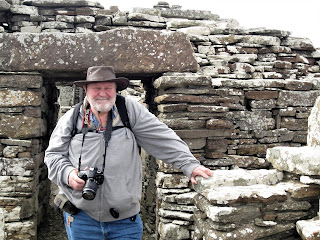 |
| Frank at the entrance to the broch |
No one knows why the prehistoric people felt the need to
build a broch (stronghold or fortress) since there were no indications of
invaders. But nevertheless, there are
140 brochs on Orkney, the Broch of Gurness included. It’s a mystery why a
farming community that should have been concentrating on growing crops put so
much time and energy into crafting these brochs. Maybe these brochs were a
symbol of power or prestige. Or maybe
the adage of Teddy Roosevelt applies here – ‘walk softly, but carry a big stick’;
the fort was created “just in case needed.”
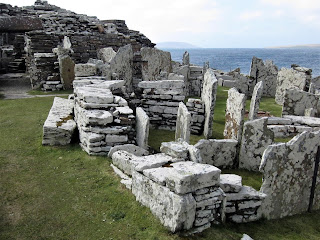 |
| Remains of homes outside the Broch of Gurness |
The broch itself was remarkable with a stately entrance that
still impresses. And all kinds of strange stone formations inside – odd shaped
scooped-out stones for holding liquids or grinding grains, and other stones
jutting out of the sides, probably for hanging crocks of grain or liquid. Outside the broch were the remains of surrounding
homes. The whole archaeological site was totally unprotected from tourists simple walking
anywhere they chose. We could walk anywhere, climb on the stones and walls, go
inside the little side homes, etc. And we pretty much had the place to
ourselves. It was a Disneyland for prehistoric spelunkers like us!
 |
The Churchill Barrier with sunken ships to
blockade the harbor |
Churchill Barriers
and Tomb of the Eagles
We drove south of the town of Kirkwall where we were staying
to the southernmost part of the island for more prehistory events and more
recent WWII history as well. This peninsula is one of the prettiest part of
Orkney with spectacular views of the water on both sides. Lots of wildlife too.
Frank saw a hare (described it as a rabbit the size of a small kangaroo), and
we all saw a curly-haired pig. Seriously, this pig had wavy hair – like the
Shirley Temple of the pig world! (Wish we had a picture. We even went back
another day “pig-hunting,” but the pig was nowhere to be seen.)
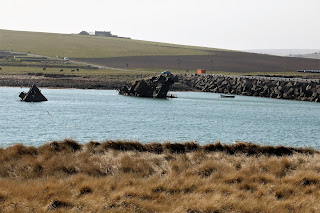 |
| More ship blocks in the Scapa Flow |
This area was also very important during WWII when Churchill
built causeways from one island to another to prevent the Nazi submarines from
entering the waters of the nearby Scapa Flow where the bulk of the British Navy
was located. As we drove across the causeways, known as the Churchill Barriers,
we could see all kinds of shipwrecks still visible in the water.
 |
| Anne entering the tomb on a trolley |
Our goal was to visit the Tomb of the Eagles, a family-owned
stone-age site at the very bottom of the peninsula. Our visit here was quite
lengthy, as family members spent time with us, sharing lots of personal information
about this discovery with us. The farmer who discovered the tomb tried for
years to get archaeologists to excavate what he had discovered, but to no
avail. They would not respond, so he finally gave up. He began to study archaeology on his own, and
eventually did the excavating himself! And he uncovered the remains of 340 skeletons
along with various tools and artifacts. His daughter passed around some of the
artifacts found at the site to the individuals in our group. Yea, we were fingering prehistoric objects
dated at 5,000-year-old!
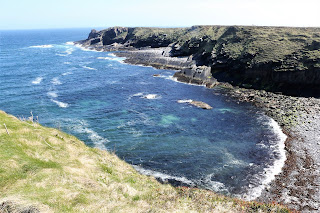 |
| Scenic cliff walk near Tomb of the Eagles |
The 2-mile easy hike to and from the site offered lots of
fine, steep, cliffside views of the crashing waves. The tomb itself was a bit
of a disappointment; however, entering the tomb was quite different from any
other we experienced. The tomb’s discoverer devised a flat “trolley” with wheels that you
lay upon and pulled yourself thru the front portal with a rope secured to the inside. The entrance way is somewhat tight and can be
claustrophobic to some. But, if the
trolley does not fit your entry style, you can always push the trolley aside
and just crawl in!
 |
| Rousay humor! |
Ferry to Rousay
We stayed on the largest Orkney island, but took a ferry to another
island known as Rousay (rhymes with "lousy", but the island was definitely NOT lousy!) for a day tour. Our guide, Patrick,
drove us all around the small island (population: 200), and once again, we took
part in the search for antiquity. Rousay
is known as “The Egypt of the North” because of the very old archaeological
digs everywhere.
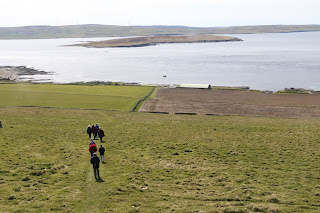 |
| Strenuous hike to Midhowe on the beach below (and back!) |
We continued to have the most incredible weather – all the
locals marveled at our luckiness with the good weather. As we made our way around Rousay, we had clear views of
several other Orkney islands. There are about 64 islands total although some of
them are uninhabited. Patrick also organized a picnic lunch in the very north
of the island, right near the beach there. Very windy location!
 |
| Bench inside Midhowe where bodies were laid to rest |
The archaeological highlight of Rousay is a site called
Midhowe. Accessing the site required a lengthy walk down a steep path to the
edge of the sea, and an excruciating hike back up. This location was popular throughout
the ages and included an iron age fort plus some medieval ruins. The unusual
cairn (tomb) consisted of one long passageway lined with benches where the dead
bodies were laid.
 |
| Taversoe Tuick, the 2-story tomb on Rousay |
We visited several other tombs as well. You could say Rousay
is just lousy with tombs! One of the best was a 2-story tomb combo called Taversoe Tuick which was a burial site for farming community folks of 4500 years ago. We climbed down a
ladder to the smaller, lower-lying tomb which made us feel like we were doing a movie
bit for Indiana Jones.
 |
| Majestic St. Magnus |
Kirkwall
We spent a day seeing the sights of Kirkwall, the largest
city in the Orkneys. Once again, we got much more than we expected. St. Magnus
in the center of town is a magnificent cathedral, one of only a few that were
not destroyed by Henry VIII in his quest to eradicate Catholicism.
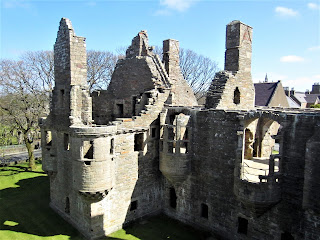 |
| Atmospheric ruins of the Earl's Palace |
And right across the street were the ruins of the Earl’s and
Bishop’s Palaces. What a historical complex! The Earl’s Palace was the best in our opinion because it was the best intact structure. It was in ruin however, but once again, we got to wander unsupervised all over it.
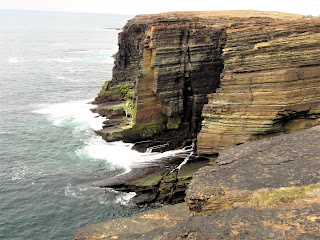 |
| Incredible scenery at Yesnaby Cliffs |
Stromness and the
Yesnaby Cliffs
On our last day, we drove along another a panoramic route to
Stromness, the second largest town (which means it is a large village). Stromness
is a harbor town that facilitates ferry connections to other islands, but the
most memorable thing for us was the drive through the town. The two-way roads
thru town were narrow for even one car in places, and required some “fancy
schmancy dancy” driving to get us thru!! Driving in old towns like this has to
be a cooperative effort. Lots of backing up to let other vehicles squeeze by,
or go first. All of this while driving a stick shift on the left. Kudos to Mr. McFrankie,
our driver supremo!
We also strolled along Yesnaby Cliffs on the western coast
of Orkney. Spectacular cliffside views and some very interesting fossils.
Everything here feels so untouched; if we were staying here long enough,
perhaps we could discover some old things too!
That brings us to the end of our Orkney adventure. We hated
to leave, but now we are on to Edinburgh!
More pics:
 |
Even the telephone booths on Orkney are
antiques! |
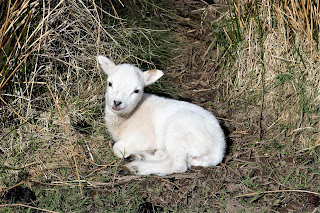 |
| Many young lambs prance around the field this time of year. |
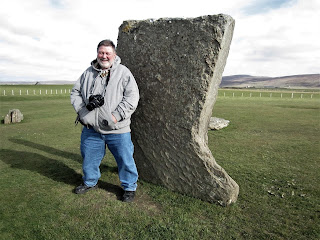 |
Frank hides from the wind behind a stone slab at
the Stones of Stennes |
 |
| Interesting timepiece at the Stones of Stennes |
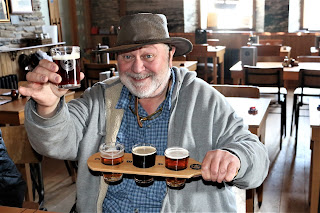 |
| Sampling the beers of Orkney |
 |
Amy climbs to the top of the
Broch of Gurness |
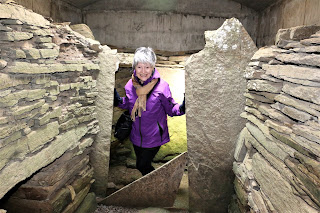 |
| "Indiana Jane" explores an ancient tomb on Orkney |
 |
Frank in the corner turret of the
Earl's Palace in Kirkwall |
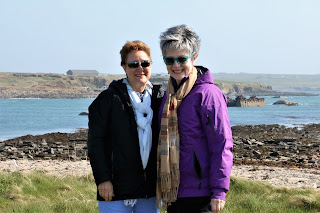 |
| Amy and Anne at the Churchill Barriers |
 |
| A favorite beer on Orkney (love the name!) |
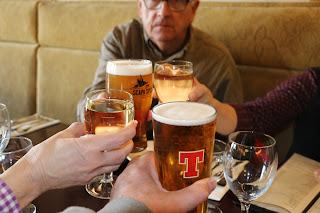 |
| Slainte mhath! (to your health) |





















